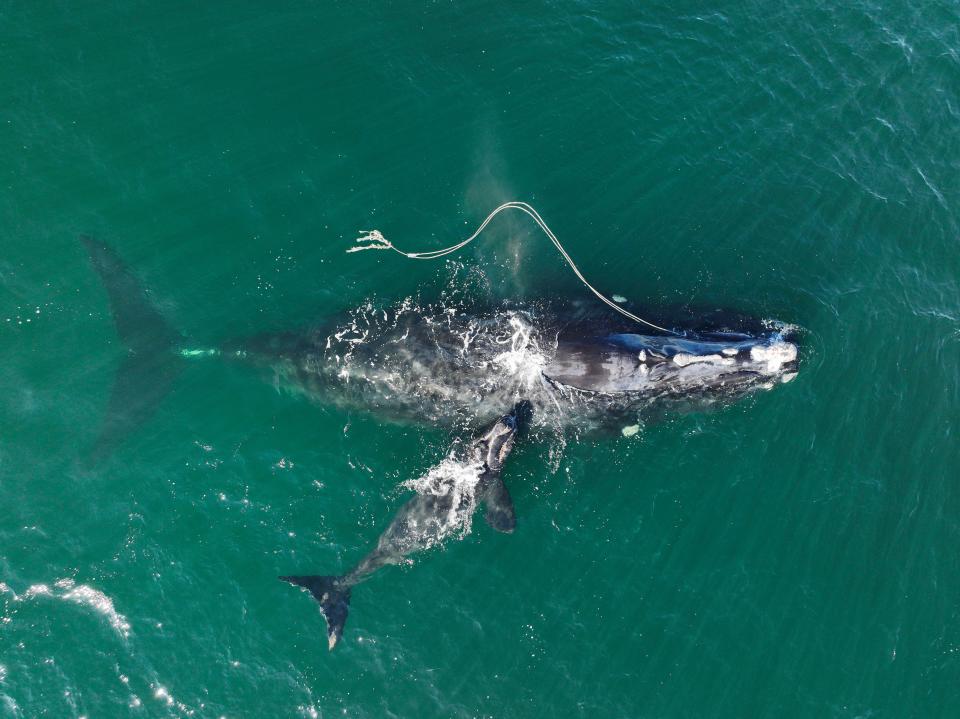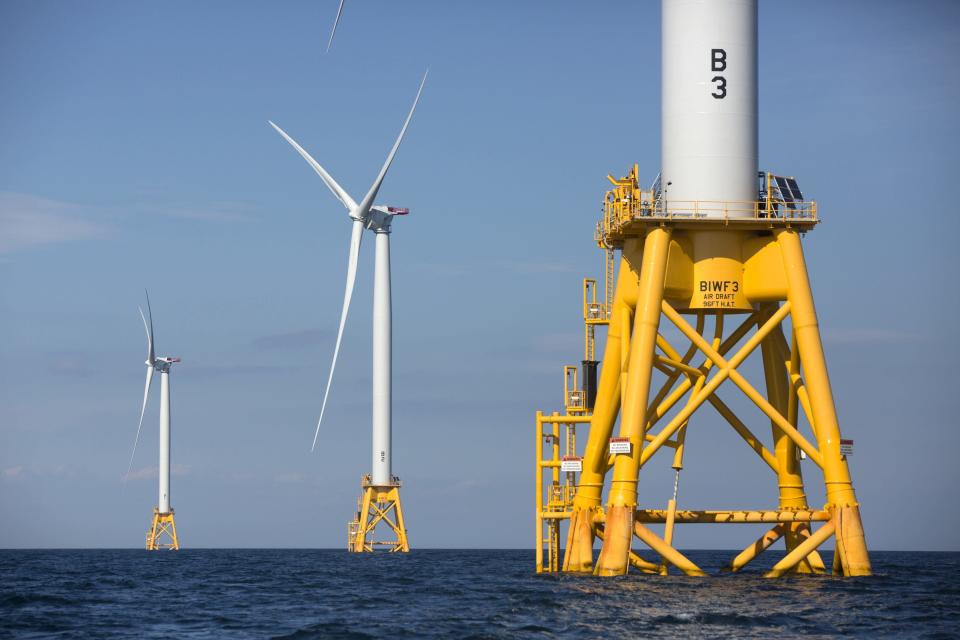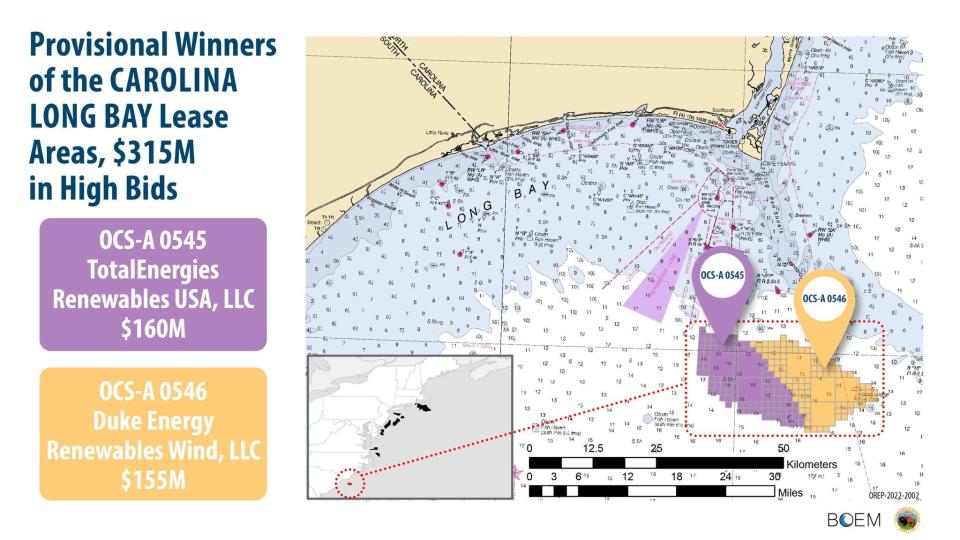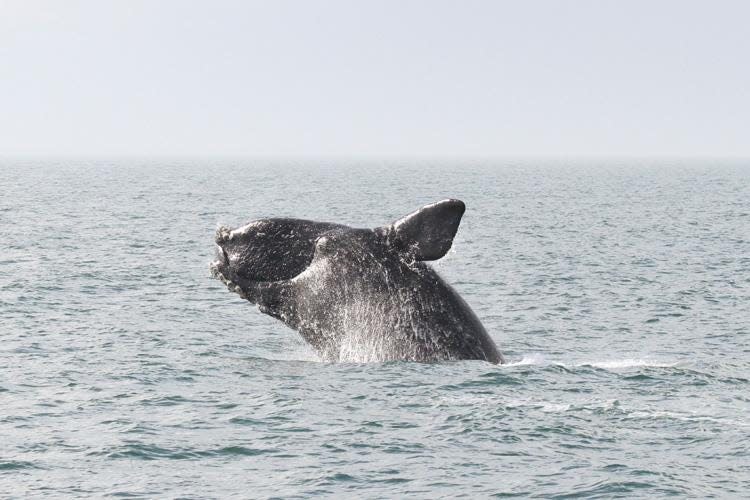For highly endangered North Atlantic right whales, offshore wind brings a lot of unknowns
The race is on to get offshore wind farms built off the U.S. East Coast, and North Carolina is one of the leading states with three projects planned for the Tar Heel Coast — two roughly 20 miles south of Bald Head Island in Brunswick County and one, which will be built first, about 27 miles off Kitty Hawk on the Outer Banks.
And they might not be the last for the state's coastal waters. While visiting a National Governors Association event in Wilmington last month, Gov. Roy Cooper was asked if he'd support more offshore wind built off the N.C. coast.
"Absolutely," he responded emphatically.

The North Carolina wind projects join other wind farms planned for the coastal waters of New England, New York, New Jersey, and Virginia as federal and state officials aggressively push to decarbonize their economies by replacing dirty fossil fuel-burning power plants with renewable energy sources. Eventually, officials are hoping to see thousands of wind turbines dotting the waters just off the East Coast, with many going up this decade.
Future Wind: Turning wind into power off the Wilmington coast could be a decade away
Last of the Right Whales: Documentary captures footage of endangered right whales
But off the coast another race is on, and the outlook for the North Atlantic right whale is much less clear than the bright future for offshore wind. This one involves the survival of a species that has been decimated by man, with some worried a push to try and fix one manmade environmental problem — an atmosphere full of greenhouse gases — could create new problems for the right whale.
“We need to develop offshore wind as a clean energy source, but we need to do it right," said Dr. Andrew Read, a marine biologist at Duke University and director of the school's marine lab. "But with right whales, we’re going to have to learn as we go.”
Many of the offshore zones planned for the East Coast's wind farms are areas known to be frequented by the whales, which generally stick to within 30 miles of shore. And the marine mammal, a favorite target of 19th-century whalers, is on the brink of extinction.
The whale's population now stands at 336 individuals, down from 500 in 2010, said Dr. Bill McLellan, a marine mammal expert who co-lead the UNCW Marine Mammal Stranding Program before his retirement. Within that population, there are only 80 reproductive females. That makes the single loss of a whale, especially a breeding female, cause for concern.
BOY SHORTAGE: NC sea turtle nests could be producing fewer males. Here's why that's a huge problem.
“We know the numbers are precise and we know the population is in decline,” McLellan said at the North Carolina Offshore Wind and Wildlife Solutions Summit last month. The event, held in Wilmington and hosted by several environmental groups, brought a variety of experts together to discuss the best ways to move forward toward responsible offshore wind development.
Uncharted waters
While offshore wind might be new to U.S. coastal waters, wind farms have been providing clean, renewable energy for decades in Europe, with more than 5,000 turbines in the waters around Europe. But environmental studies tied to those operations don't cover impacts to large, migratory whales.
Historically since the decline of the whaling industry, the biggest threats to the whales have been ship strikes and entanglements with fishing gear.
Read said those hazards, to some degree, can be mitigated by regulations, increased enforcement and educational outreach efforts.

“But the bigger question is what will happen when we have a lot of turbines installed and will it affect the migratory behavior of these animals, and I don’t think anyone knows the answer to that question," he said.
Right whales migrate along the East Coast, including off North Carolina, as they move between their summer range off Canada and New England and their winter calving grounds off the Southeastern U.S.
Climate change is another wild card for scientists and regulators as they look to create conditions to allow the wind farms and right whales to co-exist in the same stretch of ocean.
NC 12: Is new Rodanthe bridge the future of NC 12 on the Outer Banks?
CARBON CUTS: How to keep the lights on in the future: Duke, environmentalists jostle over future grid
While the warming of the planet due to man pumping greenhouse gases into the atmosphere is driving the push to adopt clean renewable energy sources like offshore wind, climate change is also having impacts on the right whales.
Read said waters in the Gulf of Maine, where the right whales spend their summer, have warmed, creating less favorable conditions for the whale's favorite food, zooplankton. That's prompted the zooplankton to move north into Canada's Gulf of St. Lawrence, and the whales have followed.
But, Read said, that's also led to increased ship strikes and whale interactions with fishing gear in Canadian waters.
"Animals will go where the food is, and the food moved northward," Read said, adding that the whales don't seem to have moved their winter calving grounds northward due to the warming ocean so far.
According to the National Oceanic and Atmospheric Administration (NOAA), there have been 51 "documented dead or serious injuries" involving North Atlantic right whales since 2017 — and the federal agency says "only about one-third of right whale deaths are documented." During that same time frame, NOAA said only 57 new calves were recorded.

'I'm optimistic'
Offshore wind supporters don't deny that interactions between the turbines, both during construction and operation, and right whales are a very real possibility.
But they stress that everyone is on board to do the right thing to try and limit impacts, including noise pollution, on the highly endangered marine mammals.
"This is not an industry that’s out there to make money at all costs," said Katharine Kollins, president of the Southeastern Wind Coalition, a nonprofit that advocates for wind energy development in the Southeastern U.S. "People don’t get involved with offshore wind for just one reason."

The federal government also is working to ease the impacts of the wind farms on the whales. In February the U.S. Bureau of Ocean Energy Management (BOEM) announced new multi-agency efforts to track and study the right whales, especially in areas planned for wind farms. BOEM also removed some areas from the initial lease areas proposed south of Brunswick County to reduce potential whale-industry impacts. Duke Energy and France-based TotalEnergies won the May auction for those two blocks, paying roughly $315 million between them to develop the two adjacent sites that cover nearly 110,000 acres.
Speakers at last month's conference in Wilmington also mentioned that several federal agencies, including the U.S. Department of Defense, are actively engaged in supporting North Atlantic right whale research, something that's expected to increase as more of the East Coast's wind farms come closer to fruition.

But will it be enough to protect the whales as thousands of offshore wind turbines move closer to installation in the migratory path of the whales, especially with a recent deal on battling climate change reached between President Biden and Democratic U.S. Sen. Joe Manchin of West Virginia potentially opening up more areas of the East Coast for offshore wind development? North Carolina is currently the southernmost state with planned wind farms.
Read, for one, is hopeful.
"I'm optimistic because we have time and research efforts are underway," he said. "We have time to plan and we have the resources and the know-how, so let’s just do this in a smart and careful way.”
Reporter Gareth McGrath can be reached at GMcGrath@Gannett.com or @GarethMcGrathSN on Twitter. This story was produced with financial support from 1Earth Fund and the Prentice Foundation. The USA TODAY Network maintains full editorial control of the work.
This article originally appeared on Wilmington StarNews: North Atlantic right whales face uncertainty, offshore wind farms

